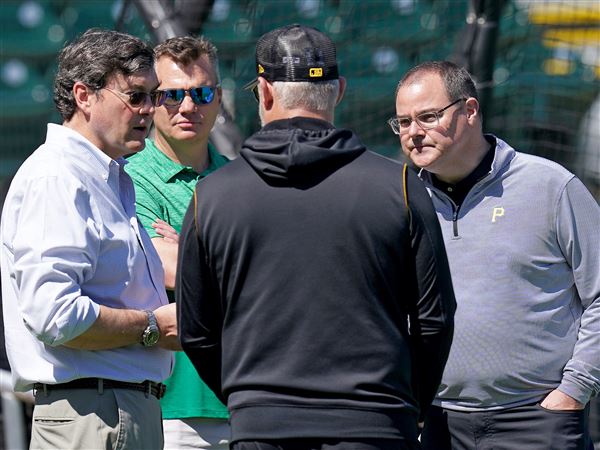As the Pirates enter the last weekend of home games, play-by-play announcer Greg Brown's signature call, "Raise the Jolly Roger" -- based in dark pirate history -- is raising the jolly spirits of the new Pirates Nation.
Fans are buying Jolly Rogers by the thousands, with Pirates retail sales now equalling those of the Steelers, even with the NFL season underway. Retailers are gushing. Fans are celebrating. And the entire region is marching toward the playoffs under skulls and crossbones.
And it all started decades ago, when Mr. Brown had a crazy idea as a Pirates front-office employee.
He thought the historic pirate theme could be exploited, so he marched to a team executive's office, knocked on the office door, and entered to find the exec's face buried in paperwork, glasses balanced on the bridge of his nose.
"What do you want?"
"I have an idea," Mr. Brown said. "When we win a ballgame, why not raise the skull and crossbones so people know that we won, as pirates did when they captured a ship."
Big pause. Big frown.
"Get out of my office, kid."
Undeterred in 1994, Mr. Brown returned to Pittsburgh as a play-by-play announcer and began contemplating a signature victory call, like Bob Prince's "We had 'em all the way," or fellow announcer Lanny Frattare's "There was nooooo doubt about it."
Early in the new millennium, Mr. Brown said he discussed several ideas with color commentator Bob Walk. "Hoist the colors?" How about something like, "Raise the skull and crossbones?" Mr. Walk informed him that the pirate flag is called a Jolly Roger.
Bingo. Soon after Mr. Brown would introduce his now famous phrase after a Pirates victory.
But signature lines, like fine wines, can take time to develop taste.
"When we started out we were losing and no one cared," he said. "It only started to catch on when we started winning the last three years."
Its time has arrived with a winning season and playoff march. Mr. Brown's call is allowing sports shops to claim their share of Pirates sports booty.
Jim Coen, owner of Yinzers in the Strip District, said he's sold out of the flag several times, with 500 flags flying out the door weekly. "It's getting to the point where it's like the Terrible Towel," he said.
A major flag supplier told him that 5,000 Jolly Roger flags were sold last week and "all went to Pittsburgh." "This time of year traditionally we're trying to give Pirates stuff away," he said. "Now I'm trying to get as much as I can get, Jolly Roger-wise."
Pittsburgh Fan, a sports shop near PNC Park, is selling 100 flags daily, making it its No. 1 selling item, store manager Michael Romano said.
Cliff Ruderer, owner of the Flag Factory, the Castle Shannon store that supplies PNC Park with its flags and the Jolly Roger, described demand as enormous, even for the higher-priced, higher-quality, American-made flags he sells.
More Jolly Roger flags are sold in Pittsburgh than any other interior city, said Robert R. Caggiano, vice president of sales for Annin Flagmakers of Roseland, N.J. "They still sell best in the coastal regions. We have seen about a 25 percent increase in the Jolly Roger offering from this year compared to last year, and I would attribute this increase to the Pirates."
The Pirates own the phrase as a trademark, Pirates spokesman Brian Warecki said. The team holds no rights to the historical skull and crossbones image.
The actual history of the Jolly Roger fills pages in the book, "Villains of All Nations," written by University of Pittsburgh historian Marcus Rediker.
The original pirate flag was red, leading to the name Jolie Rouge -- French for "beautiful and red."
During the golden age of piracy from 1710 to 1720, pirates began flying black flags, soon adding the skull and crossbones. English sailors turned Jolie into jolly and rouge into "roger" -- a derogatory sexual reference similar to the modern profanity.
Pirates would raise the Jolly Roger when approaching a merchant ship to alert captain and crew they must surrender or die.
Most ship captains surrendered.
But Mr. Rediker said the flag came to signify revolt against rich and powerful businessmen and sea captains who ran the shipping industry.
"Thousands of poor, working sailors were laboring in difficulty with low wages, low quality food, extreme strict discipline and dangerous working conditions," leaving many with peg legs, hooks for hands and eye patches, he said. They would become pirates to escape harsh conditions.
"The pirate flag symbolized this -- the life of freedom for poor working sailors," he said. "The flag had two sets of meanings associated with it."
Pirates fans say the flag means victory and more.
"It's a fantastic flag," said Lenny Long, 64, of Sunbury, Pa. "It shows we are patriotic to the team."
Jacob Emerick, 17, of Berlin, Pa., said it symbolizes Pittsburgh pride, while his dad, Jason Emerick, 42, said it intimidates other teams' fans. "I hope it's here to stay. We like it," the elder Mr. Emerick said. "The Pirates finally are something to be proud of."
Mike Sill, 25, of Rocky River, Ohio, said the flag is a unifying symbol that "represents the old Pittsburgh culture of blue collar, rough-neck people who don't give up easily and work hard every day. It's an endearing symbol.
"It's like a coat of arms," he said, noting the unique Pirates culture.
Such talk surprises the responsible party, who oversees the common spectacle of skull-spangled banners yet waving, fireworks bursting in air and fans proudly hailing victory during the spiritual ritual of the Jolly Roger rising according to his notable command.
"It's very surreal and not from an egotistical standpoint," Mr. Brown said. "I never thought it would take off to this degree, and I'm thrilled for the fans and the franchise.
"I think it took on a life of its own, and it's funny that it was a throwaway line for years because the Pirates were losing," he said. "It has morphed into something I never expected."
Correction/Clarification: (Published Sept. 20, 2013)
In an earlier version of this story, Pirates spokesman Brian Warecki's name was misspelled.
First Published: September 20, 2013, 8:00 a.m.















